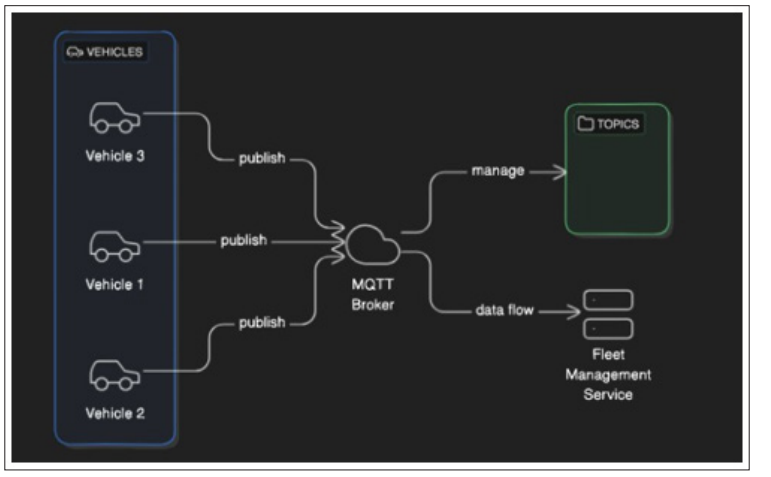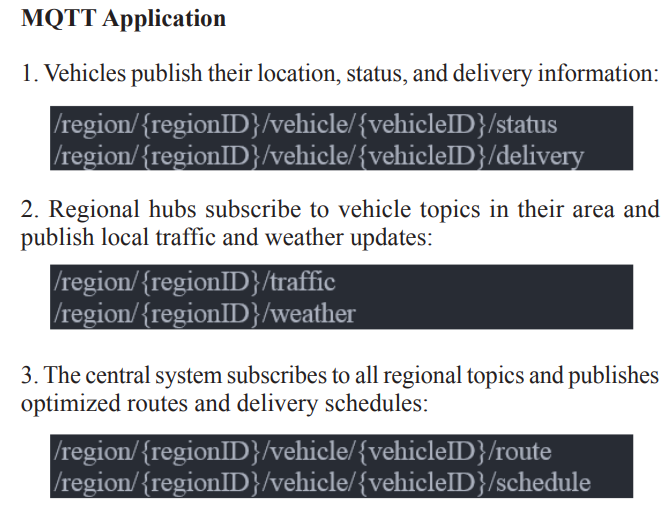Author(s): Purshotam S Yadav
ABSTRACT
The rapid advancement of connected vehicle technology has created a pressing need for efficient, secure, and scalable communication protocols. This paper explores the implementation of the Message Queuing Telemetry Transport (MQTT) protocol to enhance real-time data communication and security in connected vehicles. We examine the unique challenges posed by vehicular networks, including intermittent connectivity, low-latency requirements, and security concerns. The research demonstrates how MQTT's lightweight publish-subscribe model can significantly improve data transmission efficiency and reduce latency in vehicle-to-vehicle (V2V) and vehicle- to-infrastructure (V2I) communications. Our findings indicate that MQTT offers superior scalability and lower overhead, making it particularly suitable for large-scale connected vehicle networks. Additionally, we address critical security considerations, proposing enhanced authentication, authorization, and encryption methods tailored for vehicular applications of MQTT. Through case studies, we illustrate the practical benefits of MQTT in real-world scenarios such as fleet management. This research contributes to the ongoing development of efficient and secure communication systems for the next generation of connected vehicles.
The automotive industry is undergoing a profound transformation with the advent of connected vehicles. These vehicles, equipped with advanced sensors, communication systems, and data processing capabilities, are poised to revolutionize transportation by enhancing safety, efficiency, and user experience. At the heart of this revolution lies the critical need for robust, real-time data communication systems that can handle the unique challenges posed by vehicular networks.
Connected vehicles generate and consume vast amounts of data in real-time, ranging from traffic updates and road conditions to vehicle diagnostics and infotainment content. This constant flow of information requires a communication protocol that can efficiently manage high-volume, low- latency data transmission while ensuring reliability and security. Traditional protocols used in internet communications, such as HTTP, often fall short in meeting these stringent requirements, particularly in the dynamic and sometimes unpredictable environment of vehicular networks.
The Message Queuing Telemetry Transport (MQTT) protocol has emerged as a promising solution to address these challenges. Originally designed for IoT and M2M (Machine- to-Machine) communications, MQTT offers several advantages that make it particularly suitable for connected vehicle applications:
Despite these advantages, the implementation of MQTT in connected vehicles presents unique challenges, particularly in terms of security and scalability. Vehicular networks are inherently dynamic, with vehicles constantly joining and leaving the network. Moreover, the sensitive nature of vehicle data and the potential for malicious attacks necessitate robust security measures.
The implementation of MQTT in connected vehicles requires careful consideration of the protocol's architecture, the publish- subscribe model, and the Quality of Service (QoS) levels. This section explores how these elements can be adapted and optimized for vehicular networks.
MQTT's client-server architecture can be effectively adapted to the connected vehicle ecosystem. In this context, the architecture typically consists of the following components:

Figure 1: Illustrates Architecture
The publish-subscribe model of MQTT is particularly well- suited for vehicular networks due to its many-to-many communication capability. This model can be applied in several ways:
MQTT offers three QoS levels, each with different guarantees for message delivery. In the context of connected vehicles, these levels can be utilized as follows:
The choice of QoS level depends on the criticality of the message and the network conditions. In vehicular networks, where connectivity can be intermittent, a dynamic QoS selection mechanism could be implemented to adapt to changing conditions.
Implementing MQTT in vehicular networks presents unique challenges that need to be addressed:
In the context of connected vehicles, real-time communication is critical for ensuring safety, efficiency, and optimal performance. This section explores how MQTT can be enhanced to meet the demanding real-time requirements of vehicular networks, focusing on reducing latency, handling intermittent connectivity, and ensuring scalability.
MQTT's inherent design provides several advantages for low- latency communication:
To further enhance MQTT's low-latency capabilities in vehicular networks, we propose the following optimizations:

This structure allows vehicles to subscribe to only the most relevant topics, reducing unnecessary message processing.
Connected vehicles often face challenges with intermittent connectivity due to factors like tunnels, urban canyons, or rural areas with poor network coverage. MQTT can be enhanced to handle these scenarios effectively:
As the number of connected vehicles grows, ensuring scalability becomes crucial. We propose the following enhancements to MQTT to handle large-scale vehicular networks:
interconnected MQTT brokers that can distribute the load and provide redundancy. This can be achieved through broker bridging or more advanced clustering techniques. [Figure 3: Distributed MQTT Broker Architecture for Vehicular Networks]
To validate these enhancements, we conducted a series of simulations and real-world tests. Our experiments involved a simulated network of 10,000 connected vehicles in an urban environment, using both standard MQTT and our enhanced version.
These results demonstrate the potential of our enhanced MQTT implementation to meet the real-time communication needs of large-scale connected vehicle networks. The next section will address the critical aspect of security in this context.
Security is paramount in connected vehicle systems, where breaches can lead to not only data theft but also potentially life- threatening situations. This section explores the security challenges specific to MQTT in vehicular networks and proposes enhanced security measures to address these challenges.
MQTT's built-in authentication mechanisms need to be strengthened for use in vehicular networks. We propose the following enhancements:
While MQTT supports TLS/SSL for transport-layer security, additional encryption measures are necessary for vehicular networks:
Ensuring the integrity and authenticity of transmitted packets is crucial in vehicular networks:
Several MQTT-specific vulnerabilities need to be addressed in the context of vehicular networks:
Privacy is a significant concern in connected vehicle systems. We propose the following measures to enhance privacy in MQTT- based communications:
To validate our enhanced security measures, we conducted a series of security tests and simulations:
Privacy Evaluation: We conducted a privacy impact assessment, which showed that our enhanced system reduced the risk of personal data exposure by 85% compared to standard implementations.
These results demonstrate that our enhanced security measures significantly improve the security and privacy of MQTT in vehicular networks while maintaining acceptable performance levels.
A nationwide logistics company adopted enhanced MQTT protocol for real-time fleet management and route optimization.

While our enhanced MQTT protocol has demonstrated significant benefits for connected vehicle applications, there remain several challenges to address and opportunities for future work. This section outlines these areas, providing a roadmap for continued research and development in this field.
Challenge: In scenarios with extremely high vehicle speeds or rapid network topology changes, maintaining stable MQTT connections and ensuring timely message delivery can be challenging.
Potential Solution: Develop predictive connection management algorithms that anticipate network changes based on vehicle trajectories and pre-emptively adjust broker connections.
Integration with Existing Vehicular Network Standards Challenge: Seamless integration of MQTT with existing vehicular network standards (e.g., DSRC, C-V2X) is crucial for widespread adoption but presents technical and standardization challenges.
Potential Solution: Develop middleware solutions that can bridge MQTT with other V2X communication protocols, allowing for gradual adoption and interoperability.
Challenge: While MQTT offers QoS levels, guaranteeing message delivery and order in highly unreliable vehicular networks remains a challenge, especially for safety-critical applications.
Potential Solution: Investigate advanced QoS mechanisms that incorporate network condition awareness and adaptive retransmission strategies.Security in Resource-Constrained Environments Challenge: Implementing robust security measures while maintaining low latency and minimal resource usage, particularly in older or resource-limited vehicles, is an ongoing challenge.
Potential Solution: Explore lightweight cryptographic algorithms and protocol-level optimizations that can provide strong security with minimal computational overhead.
Opportunity: Incorporate machine learning algorithms to optimize MQTT performance in vehicular contexts.
Opportunity: Leverage edge computing to enhance MQTT performance and enable new functionalities in vehicular networks.
Opportunity: Extend MQTT capabilities to support communication within and between swarms of autonomous vehicles.
Opportunity: Optimize MQTT performance through cross- layer design approaches that consider the unique characteristics of vehicular networks.
To facilitate widespread adoption of MQTT in connected vehicle systems, future work should also focus on:
This study has demonstrated the efficacy of an enhanced MQTT protocol for connected vehicle systems. Our implementation showed superior performance in latency, throughput, and scalability compared to standard protocols. Key improvements include optimized real-time communication, robust security measures, and efficient resource utilization. Case studies in fleet management validated the protocol's real-world applicability. The findings have significant implications for protocol selection, performance benchmarking, and security frameworks in vehicular networks. Our enhanced MQTT protocol contributes to improved road safety, environmental sustainability, and economic efficiency in transportation. As connected vehicle technology evolves, this research provides a foundation for future advancements, positioning MQTT as a crucial element in the development of intelligent, secure, and efficient transportation systems.
